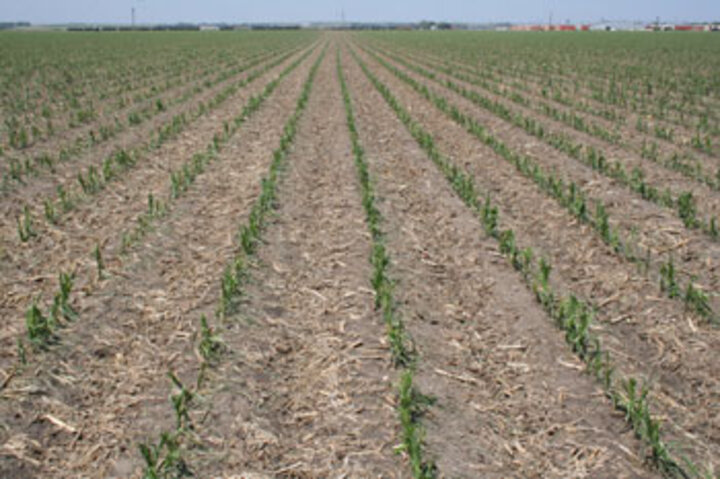
|

|
| A hail storm that swept through Colfax County and moved into Dodge County Saturday night damaged young corn plants. Many of the hardest hit fields have already been replanted. The National Weather Service reported more hail in the area Wednesday night. (Photos by Aaron Nygren) | |
May 25, 2012
|

Visit the National Weather Service Storm Prediction Center to view storm reports such as this one from Saturday, May 19.

Dry Conditions and Drought Developing
A regional view from the National Drought Monitor shows areas of concern. Yellow sections indicate abnormally dry areas while tan areas are in moderate drought. |
Tom Dorn, UNL Extension Educator in Lancaster County: Corn planting was essentially completed by May 10, and most corn plants now have 4 to 6 leaf collars showing. Soybean planting was finished this week . Most soybeans ahave 1 to 3 trifoilate leaves but some late planted soybeans flields are just emerging. Wheat has headed. Leaf disseases have diminished green leaf area in most fields, but the heads are filling now. Over 70% of alfalfa fields and some brome hay have been baled.
Jenny Rees, Extension Educator in Clay County: Parts of Clay County and the surrounding area were hit with up to golf ball-sized hail lasting up to 1/2 hour in some places last Saturday night. The area between Fairfield, Deweese, and south of Glenvil seemed to be hit the worst. Some farmers in this area who chose to leave their stands after soil crusting are replanting now due to hail loss. Corn is coming out of the hail damage as are the beans on the perimeters of the storm. The worst hit wheat is being swathed. First cutting alfalfa is up, but fields are recovering slowly as it's dry. Wheat is turning color and some farmers are talking of harvest in two weeks. Warm season grasses are slowing growth. Corn and beans in other areas of the county are looking pretty good and hilling/cultivating is occurring in corn.
Aaron Nygren, Extension Educator in Colfax County: We had a pretty good strip of hail go through Schuyler on Saturday. The strip was at least 2 miles wide and went on into Dodge County. There is some replanting going on of the worst stuff but a lot of the corn will need to be watched to see how it regrows. Quite a few bean fields also will be replanted.
Gary Lesoing, Extension Educator in Nemaha County: Corn and soybean planting is essentially completed. Corn looks very good, although there are some fields that indicate areas of nitrogen deficiency. It may be that the roots have just not grown down to the nitrogen in the soil yet. While some of the soybeans look good, soybean emergence in some fields is very poor, due to dry conditions, especially fields that have been tilled. A few farmers are irrigating corn and soybeans. It is very dry and the last good measurable rain was May 6. Some of the alfalfa second cutting has stopped growing and is blooming already. Yields will be very low. While we have a small acreage of wheat, wheat in the region is turning yellow and generally looks good. There have been reports of something feeding on the roots of corn plants, and Ii suspect it may be adult corn rootworms.
Wheat Condition Reports
Drew Lyon, Extension Dryland Cropping Systems Specialist at the Panhandle REC: I looked at a few wheat fields around Alliance on Wednesday. While frost damage was visible in the
fields I looked at, badly damaged heads were widely scattered. The vast majority of wheat heads looked good and flowering appeared to be progressing nicely. In the fields I viewed, I estimated yield loss from frost damage to be less than 5%. We will have a better feel for it in about a week when we can see how kernel development is progressing.
In the southern Panhandle, I saw little frost damage, but a lot of drought stress is showing up in portions of fields. Plants have turned blue-gray and are sloughing tillers. The small rain events so far this week have done little to quench the crop’s thirst. We are in the period of greatest water demand and Mother Nature is not providing what the crop needs. Winter wheat on summer fallow appears to be faring better than wheat on continuously cropped ground.
Karen DeBoer, Extension Educator in Cheyenne County: Wheat streak mosaic has been confirmed in two fields in Deuel County. I also have received reports of hail damage to wheat in southwest Cheyenne County. Freeze damage also occurred on May 20 in western Cheyenne County. Several other locations reported freeze damage earlier this month. We won’t know the extent of the freeze damage until harvest. The wheat crop is maturing two weeks ahead of normal and producers are saying they may be done with harvest by July 4 which is when they normally start harvest in Cheyenne County.
Jenny Rees, Extension Educator in Clay County: Wheat is rapidly turning and looks rough due to the lack of rain and major early season disease pressure. Many producers chose not to spray. At this point, given the dry conditions and hail damage, it's hard to know what would be the right decision.
